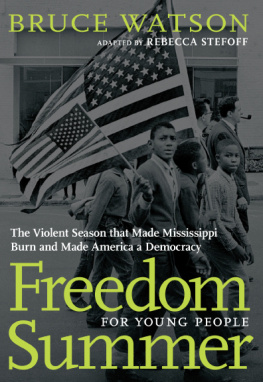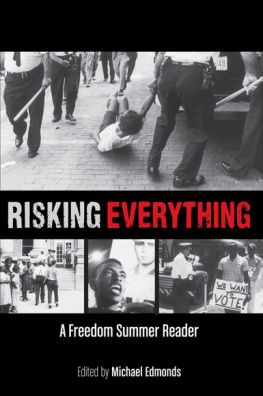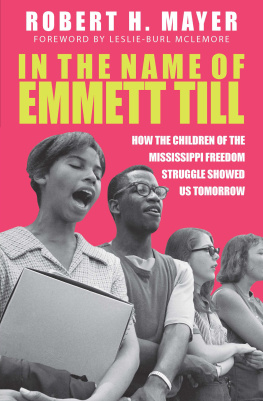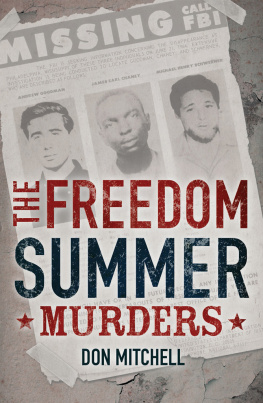To Write in the Light of Freedom
TO WRITE IN THE
LIGHT OF FREEDOM
The Newspapers of the 1964 Mississippi Freedom Schools
Edited by
William Sturkey and Jon N. Hale

Margaret Walker Alexander Series
in African American Studies
www.upress.state.ms.us
The University Press of Mississippi is a member
of the Association of American University Presses.
Copyright 2015 by University Press of Mississippi
All rights reserved
Manufactured in the United States of America
First printing 2015
Library of Congress Cataloging-in-Publication Data
To write in the light of freedom : the newspapers of the 1964 Mississippi Freedom Schools / edited by William Sturkey and Jon N. Hale.
pages cm (Margaret Walker Alexander series in African American studies)
Includes index.
This collection contains Freedom School newspapers gathered from archives, libraries, and personal collections across AmericaIntroduction.
ISBN 978-1-62846-188-6 (hardback) ISBN 978-1-62846-189-3 (ebook) 1. African AmericansMississippiSocial conditions20th century. 2. African AmericansCivil rightsMississippiHistory20th century. 3. Civil rights movementsMississippiHistory20th century. 4. Mississippi Freedom Schools. 5. African American studentsMississippiHistory20th century. 6. Student newspapers and periodicalsMississippiHistory20th century. I. Sturkey, William, editor of compilation. II. Hale, Jon N.
E185.93.M6T6 2015
323.119607307620904dc23 | 2014024113 |
British Library Cataloging-in-Publication Data available
This book is dedicated to the courageous
individuals who attended and taught in the
Mississippi Freedom Schools during the summer of 1964.
Your vision and passion continues to inspire thousands.
Contents
To Write in the Light of Freedom
Introduction
The Mississippi Freedom Schools changed lives. They opened doors for students, creating exciting new possibilities for thousands of young black Mississippians who attended them during the summer of 1964. Those eager young pupils, longing for equality and freedom, lived in a society still dominated by the unjust Jim Crow racial order that affected everything in their environment from schools to Coca-Cola machines to graveyards. That unbending system followed black Mississippians like shadows, constantly reminding that society had deemed them inferior. Daily events such as going to the movies, buying ice cream, or playing a ball game were haunted by Whites Only signs, heartless racial epithets, and the ever-present threat of violence. Jim Crow hovered over their lives and dreams, telling them no at every turn: no, they could not swim in the public pool; no, they could not take the school bus; no, they could not use the public library; and no, they would never be equal to the white children who lived across town. Freedom Schools offered something different. The Freedom Schools told them yes.
The Mississippi Freedom Schools were a series of voluntary schools conducted across the state during the summer of 1964. Organized by civil rights activists, Freedom Schools were designed to empower black Mississippi youths by supplementing their substandard public school educational opportunities with rigorous content and culturally relevant instruction. Still racially segregated a decade after the United States Supreme Courts 1954 Brown v. Board of Education decision, Mississippis black and white public schools were extremely unequal. On average, the state spent about four times as much on white students as black pupils. Everything in the African American schools was inferiordesks, chairs, windows, bathrooms, chalkboards, even the books. Many black students only received hand-me-down
Throughout the summer of 1964, black Mississippi youths rushed to the Freedom Schools in unexpected numbers, packing the churches and homes where the schools were being held. They came in droves because of the powerful educational and intellectual promise of Freedom School. Freedom Schools bolstered their students self-esteem and expectations by connecting their lives to the rich traditions of black resistance and teaching them about the rights they were supposed to have as American citizens. The experience helped many young people develop a new way of thinking and a renewed confidence in their future. As fifteen-year-old Freedom School student Albert Evans explained, Today I am the worlds footstool but tomorrow I hope to be one of its leaders. By attending Freedom School this summer I am preparing for that tomorrow. Throughout that summer, thousands of young African Americans like Albert arrived at the Freedom Schools ready to escape the boundaries of blackness in the Jim Crow South. By mid-July, over fifteen hundred students were enrolled in the Mississippi Freedom Schools. In the coming weeks they were joined by more than a thousand of their peers. Most of their lives would never be the same.
The Background of Jim Crow and Education in Mississippi
In the summer of 1964, a coalition of Mississippi-based civil rights organizations launched perhaps the most ambitious campaign of the entire Civil Rights Movement. Together, they set out to crack Mississippi, the nations most racially oppressive state. Black Mississippians had been fighting for greater freedoms since Emancipation. For nearly a century, they had been building, developing, and organizing strong communities to improve their lives under the brutal specter of Jim Crow. Optimism increased during World War II when America seemingly took a firm stance against racism. Thousands of black Mississippians joined the fight for international democracy and returned from serving their country overseas expecting to enjoy the promises of democracy at home. But they were met by white supremacists who fiercely defended Jim Crow. Still, black communities continued fighting for social equality, the right to vote, and better educational opportunities for their children. In 1960, these courageous local activists received a major boost when a representative from a civil rights organization named the Student Nonviolent Coordinating Committee (SNCC) arrived in Mississippi looking for ways to help. Four years later, that swelling coalition of local and external civil rights activists brought thousands of reinforcements from across America into Mississippi as part of an epic civil rights campaign known as Freedom Summer. It was an exciting new phase in a long struggle.
Mississippis modern white supremacist order began taking shape in 1875 when self-armed groups of white vigilantes organized to expel African Americans from the voting rolls. During the Reconstruction era that followed the Civil War, black Mississippians had been granted full citizenship, the right to vote (for males), and access to public school education. These newfound rights infuriated thousands of white Mississippians who had only known the old racial order created by slavery. The Civil War set those former slaves free, and some of the former bondspeople were even thriving, rising higher in society than many poor whites. Two African AmericansHiram Revels and Bruce Blanchehad even become United States senators. On top of that, virtually all newly enfranchised black citizens voted Republican, further drawing the ire of many white southerners who despised the Party of Lincoln. Resolving to reestablish Democratic political rule and racial domination, the states most ardent white supremacists began organizing small vigilante groups that met in secret to plan for change. As historian Vernon Lane Wharton has written, these organizations had one goal: the restoration of white supremacy in Mississippi. Their efforts culminated on election day in 1875.
Next page






